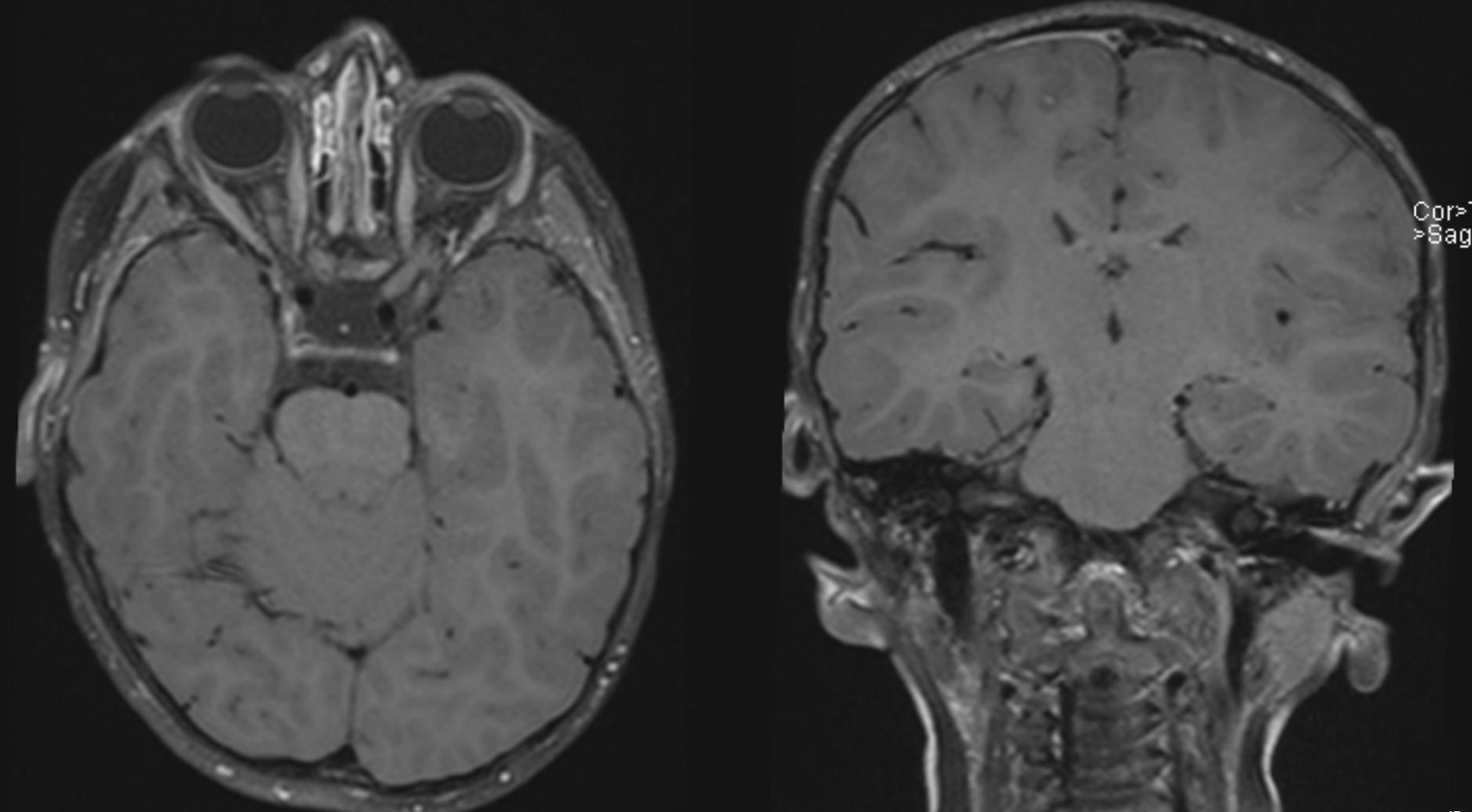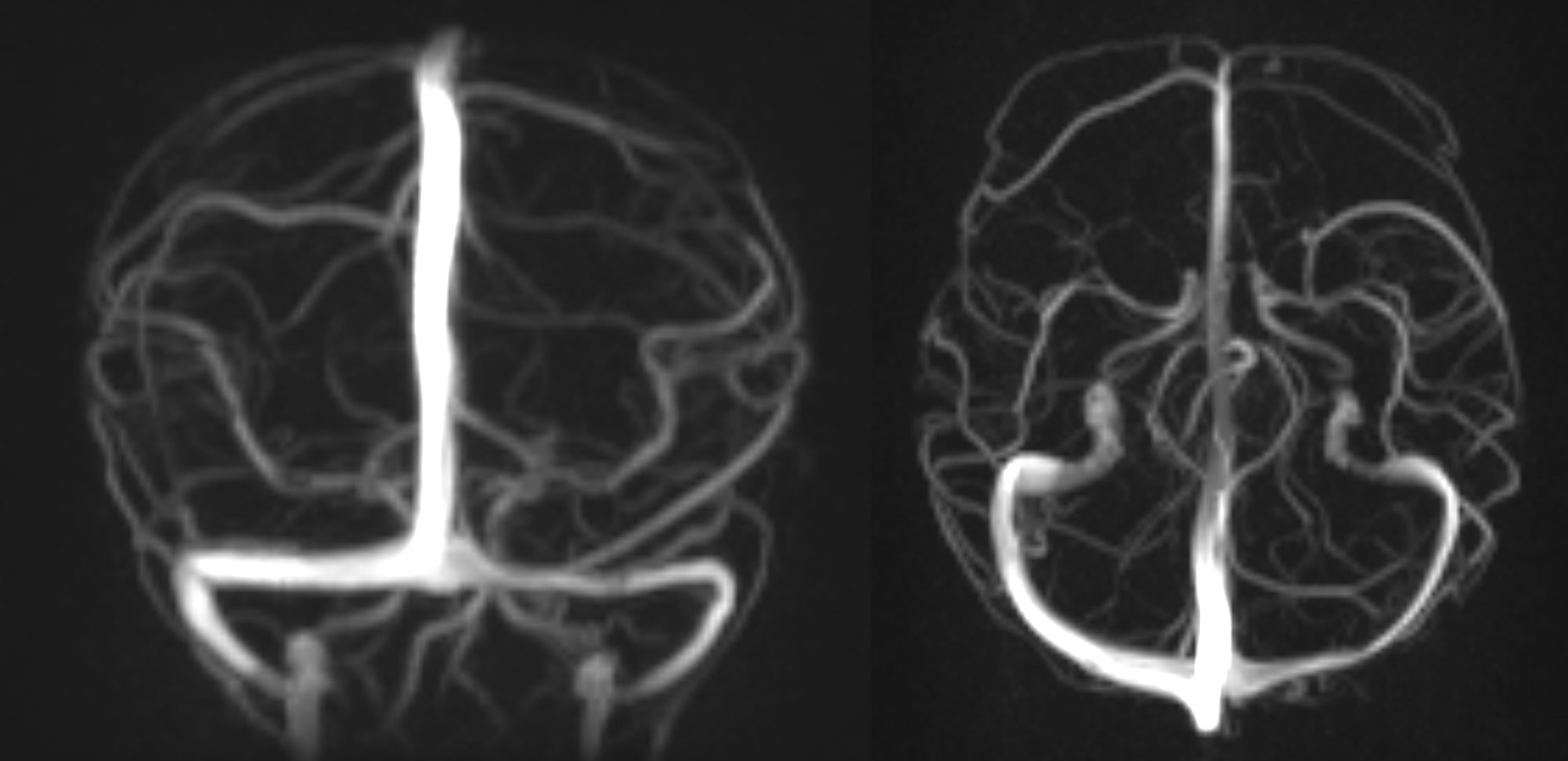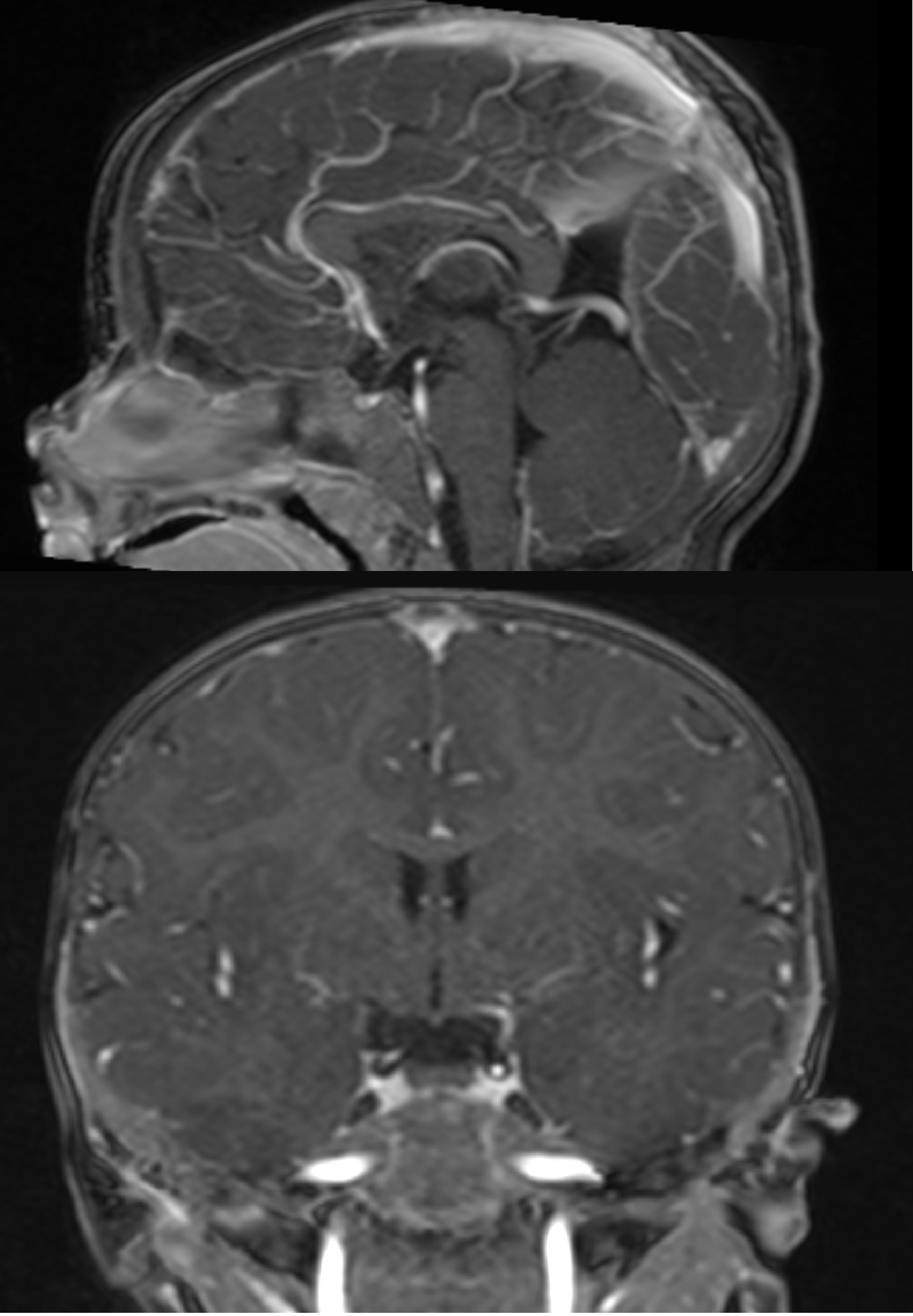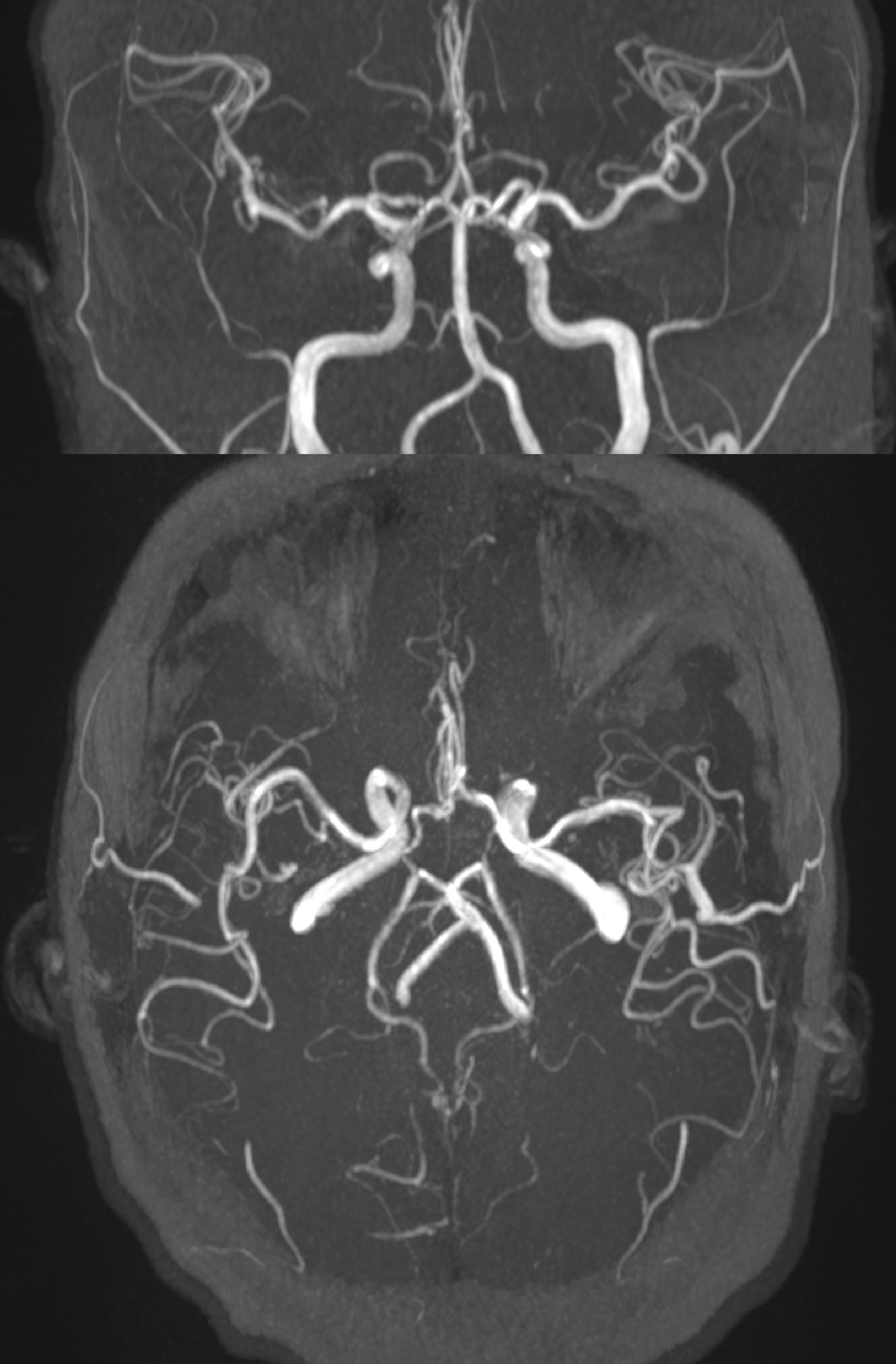[1]
Lim RP, Koktzoglou I. Noncontrast magnetic resonance angiography: concepts and clinical applications. Radiologic clinics of North America. 2015 May:53(3):457-76. doi: 10.1016/j.rcl.2014.12.003. Epub
[PubMed PMID: 25953284]
[2]
Arai N, Akiyama T, Fujiwara K, Koike K, Takahashi S, Horiguchi T, Jinzaki M, Yoshida K. Silent MRA: arterial spin labeling magnetic resonant angiography with ultra-short time echo assessing cerebral arteriovenous malformation. Neuroradiology. 2020 Apr:62(4):455-461. doi: 10.1007/s00234-019-02345-3. Epub 2020 Jan 3
[PubMed PMID: 31898767]
[3]
Brunozzi D, Hussein AE, Shakur SF, Linninger A, Hsu CY, Charbel FT, Alaraj A. Contrast Time-Density Time on Digital Subtraction Angiography Correlates With Cerebral Arteriovenous Malformation Flow Measured by Quantitative Magnetic Resonance Angiography, Angioarchitecture, and Hemorrhage. Neurosurgery. 2018 Aug 1:83(2):210-216. doi: 10.1093/neuros/nyx351. Epub
[PubMed PMID: 29106647]
[4]
Cheng YC, Chen HC, Wu CH, Wu YY, Sun MH, Chen WH, Chai JW, Chi-Chang Chen C. Magnetic Resonance Angiography in the Diagnosis of Cerebral Arteriovenous Malformation and Dural Arteriovenous Fistulas: Comparison of Time-Resolved Magnetic Resonance Angiography and Three Dimensional Time-of-Flight Magnetic Resonance Angiography. Iranian journal of radiology : a quarterly journal published by the Iranian Radiological Society. 2016 Apr:13(2):e19814. doi: 10.5812/iranjradiol.19814. Epub 2016 Mar 28
[PubMed PMID: 27679690]
[5]
Baliga RR, Nienaber CA, Bossone E, Oh JK, Isselbacher EM, Sechtem U, Fattori R, Raman SV, Eagle KA. The role of imaging in aortic dissection and related syndromes. JACC. Cardiovascular imaging. 2014 Apr:7(4):406-24. doi: 10.1016/j.jcmg.2013.10.015. Epub
[PubMed PMID: 24742892]
[6]
Kinner S, Eggebrecht H, Maderwald S, Barkhausen J, Ladd SC, Quick HH, Hunold P, Vogt FM. Dynamic MR angiography in acute aortic dissection. Journal of magnetic resonance imaging : JMRI. 2015 Aug:42(2):505-14. doi: 10.1002/jmri.24788. Epub 2014 Nov 28
[PubMed PMID: 25430957]
[7]
Fellner C, Lang W, Janka R, Wutke R, Bautz W, Fellner FA. Magnetic resonance angiography of the carotid arteries using three different techniques: accuracy compared with intraarterial x-ray angiography and endarterectomy specimens. Journal of magnetic resonance imaging : JMRI. 2005 Apr:21(4):424-31
[PubMed PMID: 15779039]
[8]
Saxena A, Ng EYK, Lim ST. Imaging modalities to diagnose carotid artery stenosis: progress and prospect. Biomedical engineering online. 2019 May 28:18(1):66. doi: 10.1186/s12938-019-0685-7. Epub 2019 May 28
[PubMed PMID: 31138235]
[9]
Hajhosseiny R, Bustin A, Munoz C, Rashid I, Cruz G, Manning WJ, Prieto C, Botnar RM. Coronary Magnetic Resonance Angiography: Technical Innovations Leading Us to the Promised Land? JACC. Cardiovascular imaging. 2020 Dec:13(12):2653-2672. doi: 10.1016/j.jcmg.2020.01.006. Epub 2020 Mar 18
[PubMed PMID: 32199836]
[10]
Dai JW, Cao J, Lin L, Li X, Wang YN, Jin ZY. [Feasibility of Non-contrast-enhanced Coronary Magnetic Resonance Angiography at 3.0T]. Zhongguo yi xue ke xue yuan xue bao. Acta Academiae Medicinae Sinicae. 2020 Apr 28:42(2):216-221. doi: 10.3881/j.issn.1000-503X.11295. Epub
[PubMed PMID: 32385028]
Level 2 (mid-level) evidence
[11]
Henningsson M, Shome J, Bratis K, Vieira MS, Nagel E, Botnar RM. Diagnostic performance of image navigated coronary CMR angiography in patients with coronary artery disease. Journal of cardiovascular magnetic resonance : official journal of the Society for Cardiovascular Magnetic Resonance. 2017 Sep 11:19(1):68. doi: 10.1186/s12968-017-0381-3. Epub 2017 Sep 11
[PubMed PMID: 28893296]
[12]
Kato Y, Ambale-Venkatesh B, Kassai Y, Kasuboski L, Schuijf J, Kapoor K, Caruthers S, Lima JAC. Non-contrast coronary magnetic resonance angiography: current frontiers and future horizons. Magma (New York, N.Y.). 2020 Oct:33(5):591-612. doi: 10.1007/s10334-020-00834-8. Epub 2020 Apr 2
[PubMed PMID: 32242282]
[13]
van Dijk LJ, van Petersen AS, Moelker A. Vascular imaging of the mesenteric vasculature. Best practice & research. Clinical gastroenterology. 2017 Feb:31(1):3-14. doi: 10.1016/j.bpg.2016.12.001. Epub 2017 Jan 5
[PubMed PMID: 28395786]
[14]
Hagspiel KD, Flors L, Hanley M, Norton PT. Computed tomography angiography and magnetic resonance angiography imaging of the mesenteric vasculature. Techniques in vascular and interventional radiology. 2015 Mar:18(1):2-13. doi: 10.1053/j.tvir.2014.12.002. Epub 2014 Dec 29
[PubMed PMID: 25814198]
[15]
Guo X, Gong Y, Wu Z, Yan F, Ding X, Xu X. Renal artery assessment with non-enhanced MR angiography versus digital subtraction angiography: comparison between 1.5 and 3.0 T. European radiology. 2020 Mar:30(3):1747-1754. doi: 10.1007/s00330-019-06440-0. Epub 2019 Dec 3
[PubMed PMID: 31797079]
[16]
Pressacco J, Papas K, Lambert J, Paul Finn J, Chauny JM, Desjardins A, Irislimane Y, Toporowicz K, Lanthier C, Samson P, Desnoyers M, Maki JH. Magnetic resonance angiography imaging of pulmonary embolism using agents with blood pool properties as an alternative to computed tomography to avoid radiation exposure. European journal of radiology. 2019 Apr:113():165-173. doi: 10.1016/j.ejrad.2019.02.007. Epub 2019 Feb 11
[PubMed PMID: 30927943]
[17]
Ley S, Kauczor HU. MR imaging/magnetic resonance angiography of the pulmonary arteries and pulmonary thromboembolic disease. Magnetic resonance imaging clinics of North America. 2008 May:16(2):263-73, ix. doi: 10.1016/j.mric.2008.02.012. Epub
[PubMed PMID: 18474331]
[18]
Hao YB, Zhang WJ, Chen MJ, Chai Y, Zhang WH, Wei WB. Sensitivity of magnetic resonance tomographic angiography for detecting the degree of neurovascular compression in trigeminal neuralgia. Neurological sciences : official journal of the Italian Neurological Society and of the Italian Society of Clinical Neurophysiology. 2020 Oct:41(10):2947-2951. doi: 10.1007/s10072-020-04419-0. Epub 2020 Apr 29
[PubMed PMID: 32346806]
[19]
Gamaleldin OA, Donia MM, Elsebaie NA, Abdelkhalek Abdelrazek A, Rayan T, Khalifa MH. Role of Fused Three-Dimensional Time-of-Flight Magnetic Resonance Angiography and 3-Dimensional T2-Weighted Imaging Sequences in Neurovascular Compression. World neurosurgery. 2020 Jan:133():e180-e186. doi: 10.1016/j.wneu.2019.08.190. Epub 2019 Sep 4
[PubMed PMID: 31493603]
[20]
Docampo J, Gonzalez N, Muñoz A, Bravo F, Sarroca D, Morales C. Neurovascular study of the trigeminal nerve at 3 t MRI. The neuroradiology journal. 2015 Feb:28(1):28-35. doi: 10.15274/NRJ-2014-10116. Epub
[PubMed PMID: 25924169]
[21]
Savolainen M, Pekkola J, Mustanoja S, Tyni T, Hernesniemi J, Kivipelto L, Tatlisumak T. Moyamoya angiopathy: radiological follow-up findings in Finnish patients. Journal of neurology. 2020 Aug:267(8):2301-2306. doi: 10.1007/s00415-020-09837-w. Epub 2020 Apr 22
[PubMed PMID: 32322979]
[22]
Lehman VT, Cogswell PM, Rinaldo L, Brinjikji W, Huston J, Klaas JP, Lanzino G. Contemporary and emerging magnetic resonance imaging methods for evaluation of moyamoya disease. Neurosurgical focus. 2019 Dec 1:47(6):E6. doi: 10.3171/2019.9.FOCUS19616. Epub
[PubMed PMID: 31786551]
[23]
Malhotra A, Wu X, Matouk CC, Forman HP, Gandhi D, Sanelli P. MR Angiography Screening and Surveillance for Intracranial Aneurysms in Autosomal Dominant Polycystic Kidney Disease: A Cost-effectiveness Analysis. Radiology. 2019 May:291(2):400-408. doi: 10.1148/radiol.2019181399. Epub 2019 Feb 19
[PubMed PMID: 30777807]
[24]
Nielsen R, Hauerberg J, Munthe S, Nielsen TH, Rochat P, Birkeland P, Rudnicka S, Gulisano HA, Sehested T, Diaz A, Karabegovic S, Sunde N. [Screening for intracranial aneurysms]. Ugeskrift for laeger. 2019 Jan 7:181(2):. pii: V05180375. Epub
[PubMed PMID: 30618370]
[25]
Alorainy IA, Albadr FB, Abujamea AH. Attitude towards MRI safety during pregnancy. Annals of Saudi medicine. 2006 Jul-Aug:26(4):306-9
[PubMed PMID: 16885635]
[26]
Mallio CA, Rovira À, Parizel PM, Quattrocchi CC. Exposure to gadolinium and neurotoxicity: current status of preclinical and clinical studies. Neuroradiology. 2020 Aug:62(8):925-934. doi: 10.1007/s00234-020-02434-8. Epub 2020 Apr 21
[PubMed PMID: 32318773]
[27]
Kitajima K, Maeda T, Watanabe S, Ueno Y, Sugimura K. Recent topics related to nephrogenic systemic fibrosis associated with gadolinium-based contrast agents. International journal of urology : official journal of the Japanese Urological Association. 2012 Sep:19(9):806-11. doi: 10.1111/j.1442-2042.2012.03042.x. Epub 2012 May 9
[PubMed PMID: 22571387]
[29]
Maki JH, Chenevert TL, Prince MR. Contrast-enhanced MR angiography. Abdominal imaging. 1998 Sep-Oct:23(5):469-84
[PubMed PMID: 9841060]
[30]
Miyazaki M, Isoda H. Non-contrast-enhanced MR angiography of the abdomen. European journal of radiology. 2011 Oct:80(1):9-23. doi: 10.1016/j.ejrad.2011.01.093. Epub 2011 Feb 16
[PubMed PMID: 21330081]
[31]
Jara H, Barish MA. Black-blood MR angiography. Techniques, and clinical applications. Magnetic resonance imaging clinics of North America. 1999 May:7(2):303-17
[PubMed PMID: 10382163]
[32]
Miyazaki M, Lee VS. Nonenhanced MR angiography. Radiology. 2008 Jul:248(1):20-43. doi: 10.1148/radiol.2481071497. Epub
[PubMed PMID: 18566168]
[33]
Wheaton AJ, Miyazaki M. Non-contrast enhanced MR angiography: physical principles. Journal of magnetic resonance imaging : JMRI. 2012 Aug:36(2):286-304. doi: 10.1002/jmri.23641. Epub
[PubMed PMID: 22807222]
[34]
Krishnamurthy R, Malone L, Lyons K, Ketwaroo P, Dodd N, Ashton D. Body MR angiography in children: how we do it. Pediatric radiology. 2016 May:46(6):748-63. doi: 10.1007/s00247-016-3614-y. Epub 2016 May 26
[PubMed PMID: 27229494]
[35]
Runge VM, Kirsch JE, Lee C. Contrast-enhanced MR angiography. Journal of magnetic resonance imaging : JMRI. 1993 Jan-Feb:3(1):233-9
[PubMed PMID: 8428091]
[36]
Klisch J, Strecker R, Hennig J, Schumacher M. Time-resolved projection MRA: clinical application in intracranial vascular malformations. Neuroradiology. 2000 Feb:42(2):104-7
[PubMed PMID: 10663484]
[37]
Hennig J, Scheffler K, Laubenberger J, Strecker R. Time-resolved projection angiography after bolus injection of contrast agent. Magnetic resonance in medicine. 1997 Mar:37(3):341-5
[PubMed PMID: 9055222]
[38]
Behzadi AH, Zhao Y, Farooq Z, Prince MR. Immediate Allergic Reactions to Gadolinium-based Contrast Agents: A Systematic Review and Meta-Analysis. Radiology. 2018 Feb:286(2):471-482. doi: 10.1148/radiol.2017162740. Epub 2017 Aug 25
[PubMed PMID: 28846495]
Level 1 (high-level) evidence
[39]
Delfino JG, Krainak DM, Flesher SA, Miller DL. MRI-related FDA adverse event reports: A 10-yr review. Medical physics. 2019 Dec:46(12):5562-5571. doi: 10.1002/mp.13768. Epub 2019 Oct 8
[PubMed PMID: 31419320]




